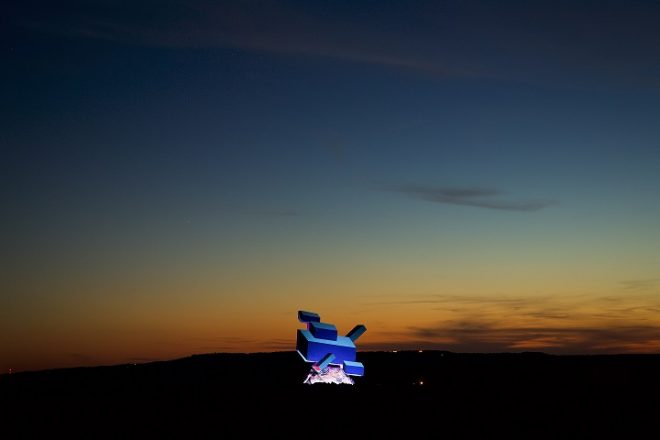Grounded Figures, Studies of Light, Color and Art

WORDS / MARGARET H. ADAMS
PHOTOS / NICK GIBSON
The photograph Grounded Figure 1 (2019) shows the familiar sight of an Ozark skyline at sunset. The soft glow of a radio tower and the lights of a small town flicker in the background, soon to become brighter and more prominent as the sunlight fades away. But the image is more dreamscape than landscape. Peculiar yet vital to the photograph is the foregrounded blue and purple geometric figure, clearly out of place in the natural surroundings. Its rigid shape and split complementary colors create an aesthetic dialogue tension with the countryside’s rolling hills and the changing hues of the sunset. And although the flat art object looks superimposed on a pre-existing photograph, it’s not – the abstract form is a physical artwork made of plywood and paint by the Fort Smith artist Buffalo.
For the work Grounded Figure 1, Buffalo collaborated with local photographer and videographer Nick Gibson. This photograph is part of a larger series called Grounded Figures. This title is a play on words describing the formal relationship between the foreground, background and art figure in the photographs. Further, the serie’s title refers to the natural flow of electricity to ground, highlighting the thematic importance of lighting in the artworks. The artistic duo started working on this experimental project in early December 2018. Buffalo constructs and paints the art objects, and Gibson scopes out a location and photographs.
Buffalo and Gibson’s artwork is meant to entice the audience’s eye, as well as to encourage the viewer to perceive the nuances of colors, light and time in environments they could easily take for granted. “The work is sensory exaltation—a glorification of the creative and perceptive capabilities of the evolutionary marvel which is the eye. Moreover, it’s a celebration of existence,” says Buffalo.
The Fort Smith artist, who is known for his street art in skate parks and 2018’s The Unexpected, challenges the institutionalization of art. His works are not meant to hang from a spotless wall or stay perched on a pretty pedestal. Grounded Figures rejects traditional art spaces, like museums and galleries, and embraces liminal spaces of Northwest Arkansas’s local landscape. These works revel in transitions whether it’s light, time, color, space or ritual.
Among Buffalo’s many influences are James Turrell, Tony Smith, Frank Stella, Carmen Herrera, Felipe Pantone and Carlos Cruz-Diez, who all work closely with color and geometric abstraction. Buffalo and Gibson plan to continue their collaboration, experimenting with photographic techniques and video shots from a drone. According to Gibson, the public can watch their creative experiments through Instagram. In personal opinion, however, Gibson’s work is striking and deserves to be viewed in a medium much larger than a phone screen.
Shooting the Grounded Figures series is not an easy feat, and the two artists collaborate with each other every step of the way. Gibson, who is an avid hiker, often selects shooting locations based on an artistic concept Buffalo suggests. The photographer considers remote destinations that extol the natural Arkansas landscape, as well as urban environments, like construction sites and city skylines. Lugging these art objects outdoors is not an easy feat, and the creative duo is quick to assert that Grounded Figures is a work in progress.
As Gibson and Buffalo review the images taken from their excursions, the two discuss the successes and problems of the photos and videos—the drone shot could’ve been slower; there’s distracting debris in a few shots; the wood paneling showed too much texture in a close-up shot. “It’s invigorating. We’re excited to continue the work. It doesn’t always work out the first time and honestly, I’d be upset if it did,” says Buffalo, who asserts that the trial and error process of Grounded Figures is a large part of his creative process.
Buffalo explains that working in nature personally reveals more about his art practice, rather than producing works in a studio. “My work is based on a distinctly human urge to make things exist that don’t yet exist. My aim is to construct objects into a coordinated scene which celebrates the creative capabilities all humans possess,” says the artist. This is apparent in Gibson’s photographs, which capture the bizarre insertion of Buffalo’s artificial artworks in the natural landscape, like some type of mythical object. The experimental Grounded Figures series is a powerful reminder of the eye’s and mind’s capabilities. Like Buffalo and Gibson’s work suggests, this optical potential should be treated like a celebration even in familiar environments.
IG / @buffalawrt / @nbgiphonephotos
A previous version of this article listed the photographer’s last name as “Gipson,” not “Gibson.” The article has been adjusted to reflect the correct name spelling.




Comments